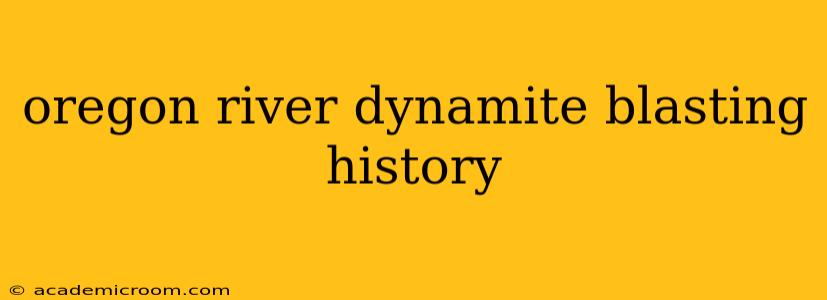Oregon's rivers, with their powerful currents and sometimes unpredictable flows, have presented unique challenges throughout the state's history. From the earliest days of settlement to modern-day infrastructure projects, the use of dynamite blasting has played a significant, albeit controversial, role in shaping these waterways. This article delves into the history of dynamite blasting in Oregon's rivers, exploring its applications, impact, and the ongoing debate surrounding its use.
Early Uses of Dynamite Blasting in Oregon Rivers
The introduction of dynamite in the late 19th century revolutionized various industries, and river management in Oregon was no exception. Initially, dynamite blasting was primarily used for:
-
Navigation Improvement: Early settlers and burgeoning industries needed navigable waterways for transportation. Dynamite blasting was employed to remove rocks and obstructions from river channels, creating deeper and wider passageways for boats and barges. This was particularly crucial for logging operations, where transporting timber was paramount.
-
Hydraulic Mining: During the gold rush era, hydraulic mining relied heavily on high-pressure water jets to dislodge gold-bearing gravels. Dynamite blasting was frequently used to break up larger rock formations and enhance the effectiveness of hydraulic mining operations. The environmental consequences of this practice, however, are now well-documented.
-
Dam Construction: As the state developed, the construction of dams required extensive rock removal and excavation. Dynamite blasting became an essential tool in building the foundations and channels needed for hydroelectric projects and water storage.
The Environmental Impact of River Dynamite Blasting
While dynamite blasting provided tangible benefits in terms of navigation and resource extraction, its environmental impact has been a subject of ongoing concern. The immediate effects include:
-
Habitat Disruption: Explosions can severely damage or destroy aquatic habitats, affecting fish populations, invertebrates, and other riverine organisms. The shockwaves from the blasts can kill or injure wildlife, and the resulting sediment cloud can smother sensitive benthic communities.
-
Water Quality Degradation: Blasting can release sediment into the water, leading to increased turbidity and impacting water quality. This can harm aquatic life and affect drinking water sources.
-
Slope Instability: In some instances, blasting can destabilize riverbanks and slopes, leading to erosion and increased risk of landslides.
Modern Regulations and Best Practices
In response to growing awareness of the environmental risks associated with dynamite blasting, Oregon, like many other states, has implemented regulations to mitigate its impact. These regulations often include:
-
Environmental Impact Assessments: Before any blasting project can commence, a thorough environmental assessment is usually required to evaluate potential impacts and identify mitigation strategies.
-
Permitting Requirements: Blasting operations are typically subject to strict permitting processes, ensuring compliance with environmental regulations.
-
Monitoring and Reporting: Projects often involve ongoing monitoring to assess the effectiveness of mitigation measures and report on any unforeseen consequences.
What are the long-term effects of dynamite blasting in Oregon rivers?
The long-term effects can be subtle but significant. Sedimentation from blasting can alter river morphology over time, affecting flow patterns and habitat availability. The cumulative impact of multiple blasting events across a river system can have substantial, long-lasting consequences for the overall ecological health of the waterway. Research continues to examine the full extent of these long-term effects.
What alternatives to dynamite blasting exist for river management?
Modern river management techniques are increasingly employing less destructive alternatives to dynamite blasting, including:
-
Mechanical Excavation: Using heavy machinery like excavators and bulldozers to remove rocks and other obstructions. This is often more expensive but less disruptive to the environment.
-
Hydraulic Dredging: Utilizing high-pressure water jets to remove sediment and reshape river channels. While still potentially impactful, it offers more control than blasting.
-
Bioengineering Techniques: Employing natural materials like vegetation and logs to stabilize riverbanks and channels. This approach prioritizes ecological restoration and sustainability.
Is dynamite blasting still used in Oregon rivers today?
While less prevalent than in the past, dynamite blasting might still be used in specific circumstances where other methods are deemed impractical or ineffective. However, the trend is towards employing less disruptive alternatives whenever possible, reflecting a greater emphasis on environmental protection and sustainable river management practices.
This overview provides a historical perspective on the use of dynamite blasting in Oregon's rivers, highlighting its significance, environmental consequences, and the shift towards more sustainable approaches to river management. The ongoing dialogue surrounding its use underscores the importance of balancing human needs with the preservation of Oregon's invaluable natural resources.
